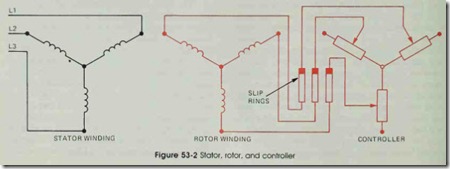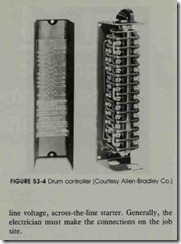Objectives
After studying this unit, the student will be able to:
• Identify terminal markings for wound rotor (slip ring) motors and controllers
• Describe the purpose and function of manual speed control and wound rotor motor applications
• Explain the difference between two-wire and three-wire control for wound rotor motors
• Connect wound rotor motors with manual speed controllers
• Recommend solutions to troubleshoot problems with these motors
The ac three-phase wound rotor, or slip ring, induction motor was the first alternating-current motor that successfully provided speed control characteristics. This type of motor was an impor tant factor in successfully adapting alternating cur rent for industrial power applications. Because of their flexibility in specialized applications, wound rotor motors and controls are widely used throughout industry to drive conveyors for mov ing materials, hoists, grinders, mixers, pumps, variable speed fans, saws, and crushers. Advan tages of this type of motor include maximum uti lization of driven equipment, better coordination with the overall power system, and reduced wear on mechanical equipment. The wound rotor mo tor has the added features of high starting torque and low starting current. These features give the motor better operating characteristics for applications requiring a large motor or where the motor must start under load. This motor is especially de sirable where its size is large with respect to the capacity of the transformers or power lines.
The phrase “wound rotor” actually describes the construction of the rotor. In other words, it is wound with wire. When the rotor is installed in a motor, three leads are brought out from the rotor winding to solid conducting slip rings, figure 53-1. Carbon brushes ride on these rings and carry the rotor winding circuit out of the motor to a controller. Unlike the squirrel cage motor, the in duced current can be varied in the wound rotor motor. As a result, the motor speed can also be varied, figure 53-2. (Wound rotor motors have sta tor windings identical to those used in squirrel cage motors.) The controller varies the resistance (and thus the current), in the rotor circuit to control the acceleration and speed of the rotor once it is operating.
Resistance is introduced into the rotor circuit when the motor is started or when it is operating at slow speed. As the external resistance is elimi nated by the controller, the motor accelerates.
Generally wound rotor motors under load are not suitably starting with the rings shunted. If such a motor is started in this matter, the rotor resistance is so low that starting currents are too high to be acceptable. In addition, the starting torque is less than if suitable resistors are inserted in the slip-ring circuit. By inserting resistance in the ring circuit, starting currents are decreased and starting torque is increased.
A control for a wound rotor motor consists of two separate elements: (1) a means of connecting the primary or stator winding to the power lines, and (2) a mechanism for controlling the resistance in the secondary or rotor circuit. For this reason, wound rotor motor controllers are often called sec ondary resistor starters.
Basically, there are two types of manual con trollers, starters and regulators. The resistors used in starters are designed for starting duty only. This means that the operating lever must be moved to the full ON position. The lever must not be left in any intermediate position. The resistors used in regulators are designed for continuous duty. As a result, the operating lever in regulators can be left in any speed position.
When wound rotor motors are used as adjust able speed drives, they are operated on a continu ous basis with resistance in the rotor circuit. In this case, the speed regulation of the motor is changed, and the motor operates at less than the full-load speed.
The use of three-wire control for starting (normally closed control contact), figure 53-3, means that low-voltage protection is provided. The motor is disconnected from the line in the event of voltage failure. To restart the motor when the voltage returns to its normal value, the normal starting procedure must be followed. To reverse the motor, any two of the three-phase motor leads may be interchanged.
Drum controllers, figure 53-4, may be used for manual starting. The drum controller, how ever, is an independent component; it is separate from the resistors. A starting contact controls a line voltage, across-the-line starter. Generally, the electrician must make the connections on the job site.
REVIEW QUESTIONS
1. What characteristic of wound rotor motors led to their wide use for industrial applications?
2. By what means is the rotor coupled to the stator?
3. What other name is given to the wound rotor motor?
4. Does increased resistance in the rotor circuit produce low or high speed?
5. What two separate elements are used to control a wound rotor motor?
6. What is the difference between a manual starter and a manual regulator?



